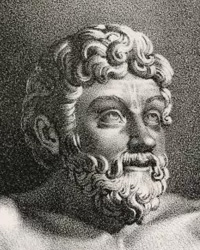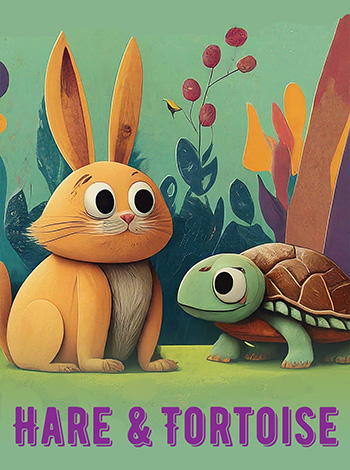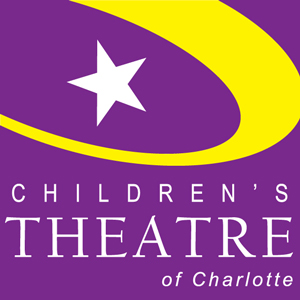Resource Guide - Hare & Tortoise
About the show
Meet two competing friends in this fantastic adaptation of Aesop’s fable. Hare & Tortoise is a story about racing, opposites, time, and friendship. From sun-shining spring to snow-falling winter, this much-loved story is brimming with ideas, characters, music, and wonderful physicality. Join Hare and Tortoise in the greatest race on earth with a nail-biting, seconds-ticking, medal-winning end...THEMES: FRIENDSHIP, PATIENCE, UNDERSTANDING, TIME, LETTING GO
The BIG questions before the show
- Can you remember a time when you were so excited for something that you felt like you couldn’t wait? Like waiting for yummy chocolate chip cookies to bake, or waiting all year for your birthday, or waiting for your turn to go down the slide?
- What is your favorite season of the year and what do you like to do? Building a snowman in the winter? Jumping in rain puddles in the spring? Going swimming in the summer? Going to the pumpkin patch in the fall?
NC SL.K-5.2 Ask and answer questions about key details in a text read aloud or information presented orally or through other media. Goal LDC-2: Children participate in conversations with peers and adults in one-on-one, small, and larger group interactions. Goal CD-9: Children explore concepts connected with their daily experiences in their community.
Pantomime
Pantomime is a type of acting using gestures and facial expressions but no sounds or words. Lead students through a creative pantomime activity in the classroom. Encourage the class to act out the activity together as a class.Using the four seasons, describe an environment to students (we list suggestions below) and explain they’ll act out activities within this environment without using any words or sounds. After the class has had an opportunity to explore, ask them to sit on the floor and encourage a few students to show their activity. See if the rest of the class can guess what they’re doing!
- Walking in the snow without a coat on (shiver, blow warm breath on hands)
- Having a picnic, smelling flowers, chasing butterflies (being butterflies)
- Swimming in the summer, eating ice cream, flying a kite
- Shoveling leaves, picking up a huge pumpkin, trick or treating
NCES Theatre Arts K-5.C.2 Use performance to communicate ideas and feelings. NCES.HEALTH.(K-2).ICR.1: Understand healthy and effective interpersonal communication and relationships. Goal HPD-4: Children develop the large muscle control and abilities needed to move through and explore their environment.
Just A Little Celebration Dance Party
In the play, Hare loves to celebrate his wins. Sometimes it’s fun to cheer ourselves on. This activity will teach students the power of celebrating each other and themselves. Draw a smiley face on a ball, balloon, or bean bag. Stand in a circle. Put on some upbeat music and ask the kids to toss the smiley face to each other one person at a time. Whoever is holding the smiley face when the music stops jumps up and says “I did it!” and everyone cheers them on by shouting “You did it!” The goal is to have fun and celebrate even our smallest wins.Goal HPD-5: Children develop small muscle control and hand-eye coordination to manipulate objects and work with tools. Goal ESD-7: Children recognize and respond to the needs and feelings of others.
The BIG questions after the show
- What was the Hare excited to do with Tortoise?
- At the beginning and the end of the play, Tortoise is sleeping. Why do you think she needs to sleep in the winter?
- What does this story teach us about friendship?
- What does this story teach us about being patient? Can you remember specific events that happened in the story? Why is it important to be patient?
- The moral (or “lesson”) of the fable version is “Slow and steady wins the race.” What does that mean? In the play version, the lesson is not just about being consistent, but also about savoring every moment. If you could write a one sentence moral of the play, what would it be? What are some ways you can follow Tortoise’s lesson in your own life?
Goal LDC-2: Children participate in conversations with peers and adults in one-on-one, small, and larger group interactions. Goal CD-9: Children explore concepts connected with their daily experiences in their community. CCSS.ELA-Literacy.SL.(K-5).2: Ask and answer questions about key details in a text read aloud or information presented orally or through other media. NCES-HealthEd.3.ICR.1.4: Illustrate how to effectively and respectfully express opinions that differ
Getting Ready for the Race Pantomime
Review pantomime with students (Pantomime is a type of acting using gestures and facial expressions but no sounds or words.) Tortoise spent all year long getting ready for the race. In this activity walk students through pantomiming key moments of the play and instruct their actions by reciting a few lines.Teacher: The world is winter: shivering, shaking.
Pantomime Winter
Waking up, yawning, and putting on glasses, Shivering in the cold, warming their hands.
Students: The world is winter: shivering, shaking.Teaching: The world was winter: shivering, shaking. Now the world turns and buds blossom… breathing, branching. It’s time to clean! The world is springtime: breathing, branching.
Students: The world is springtime: breathing, branching.
Pantomime Spring
Washing face, combing hair, brushing teeth.
This is a perfect time for the teacher to pantomime with the students. Pantomime a packet of seeds.Teacher: Carrots?
Students: Carrots!
Pantomime handing students 4 carrot seeds
Teacher: In the spring we plant seeds. 1, 2, 3, 4. And now we dig our holes.
The teacher demonstrates by taking your index finger and pantomime digging four holes in the ground. Instruct students to do the same and then pantomime placing four seeds in the four holes and covering them up.
Students: 1, 2, 3, 4.
Teacher: The world was springtime: breathing, branching. Now the world turns and the sun sizzles. The world is summer: sweltering, swooning.
Pantomime Summer
Carrying a picnic basket, laying down a blanket, taking out tasty foods, and eating them. Ice Cream cones.
Teacher: Time to go for a swim. Give students a moment to pantomime swimming and then the teacher begins blowing.
Teacher: The world was summer: sweltering, swooning. Now the world turns and grows golden. The world is autumn: gleaming, glowing. It’s time to train! Like this.
Pantomime Autumn
Teacher pantomime simple stretches: Knee Bend, Chest Stretch, Toe Touch
Teacher: Now it’s time to race. On your marks. Get set. Go!Have fun with this pantomime. Students can run as fast as they can in place then switch it up and have the run in slo-mo, as slow as they can.
Teacher: Now we celebrate, shout, and cheer. You did it!
Students: We did it!
Teacher: (Yawn and stretch) The world was autumn: gleaming, glowing. We all went racing, running and winning. The world turns and snow is falling… frosty, freezing. The world is winter: shivering, shaking.
Pantomime Winter
Shivering in the cold, warming their hands, yawning, settling in bed, and sleeping.
Teacher: The world is winter: shimmery and shining. We are sleeping safe and soundly.
The End
Goal HPD-4: Children develop the large muscle control and abilities needed to move through and explore their environment. Goal CD-11: Children compare, sort, group, organize, and measure objects and create patterns in their everyday environment.
Talk about jobs in the theatre
Every play Children’s Theatre of Charlotte produces is created by a talented team of designers, technicians, actors and a director. As a class, discuss what you experienced when you saw the performance.- Name three things you noticed about the set. Did the set help tell the story? What sort of set would you design?
- What did you like about the costumes? Did the costumes help tell the story? What sort of costumes would you design?
- Talk about the actors. Were there moments you were so caught up in the story you forgot you were watching a play?
- Were there any actors who played more than one character? What are some ways you can show you are a different character?
NCES-TheaArts.(K-5).TA.A.1: Analyze literary texts and performances. NCES-TheaArts.(K-5).TA.AE.1.2: Understand how costumes [and technical elements] enhance dramatic play.
Recommended Reading
If you enjoyed the show, travel to ImaginOn or your local Charlotte Mecklenburg library branch and check out these books. Check availability at cmlibrary.org.- Lion and Mouse by Jairo Buitrago
- The Fastest Tortoise in Town by Howard Calvert
- The Rabbit and the Turtle by Eric Carle
- The Ant and the Grasshopper by Rebecca Emberley
- Hare and Tortoise by Alison Murray
- The Tortoise & the Hare by Jerry Pinkney
About the Creators
 About the Playwright About the Playwright
Brendan Murray grew up in Salford, Lancashire in northwest England. Following a degree in Drama from Huddersfield Polytechnic, he trained as an actor at Drama Studio London and worked in regional repertory, commercial touring, fringe and young people’s theatre. Between 1982 and 1985 he was Head of Theatre-in-Education at The Belgrade Theatre Coventry, writing and directing plays for schools, the studio theatre and the main stage. Teaching includes work for The Department of Education, The Central School of Speech and Drama, Sheffield Hallam University, Rose Bruford College, The Actors' Institute and Drama Studio London, where he is a tutor and Associate Director. |
|
|
 About Aesop About Aesop
There are many mentions of Aesop in Greek history, but very few actual facts exist about his life. Based on the information that has been recorded, Aesop is thought to have lived between 620 and 560 B.C. Scholars believe that he may have been a slave who was granted freedom because of his keen ability to tell a good story. The stories that he told were not initially written down, but rather passed along orally from person to person. Over 600 stories are credited to his name, although many historians agree that some of the fables attributed to Aesop could not possibly have been written by him. Some scholars even doubt whether Aesop even existed at all since there is so little evidence to confirm that he was a real person. Aesop’s fables have reached countless generations and the lessons taught in his stories remain relevant today. |

Adapted from Aesop's fable by Brendan Murray | Produced by special arrangement with Plays for New Audiences





